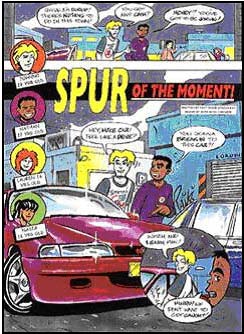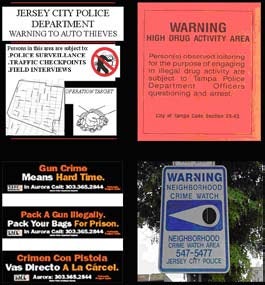
Center for Problem-Oriented Policing
Elements to Consider When Designing a Publicity Campaign
Poorly designed publicity campaigns are unlikely to produce the desired results. This section highlights some of the major considerations surrounding crime prevention publicity efforts.
Ineffective campaigns usually result from:
- making faulty assumptions concerning the nature of the message
- targeting the wrong audience
- improperly implementing the effort.
To avoid problems, it is a good idea to pretest publicity campaigns with a sample target audience to ensure that the content has sufficient appeal and communicates the correct message.34
Nature of Message
The campaign message comprises several important elements, discussed below.
Content
The message content is any campaign's central component.
- The message needs to be relevant to the target audience by being salient and timely.35
- If victims are the target audience, the message should avoid blame, because most people will not pay attention to a campaign reminding them of their shortcomings.36
- Research shows that messages warning offenders of an increased risk of arrest are more successful than those that focus on the legal consequences if one is caught
- Campaigns should not include terms such as "battle," "war effort," "spreading cancer," or "scourge" when referring to crime.37
Source
When it is appropriate to identify the agency responsible for the publicity campaign, avoid giving off an air of superiority when delivering the message, as this may turn off the audience, leading them to reject it. There may be times, however, when not identifying the agency producing the publicity campaign may prove beneficial. For example, a campaign targeting graffiti problems is likely to fail if it is sponsored by the Department of Public Works. While this agency may be responsible for implementing and reaping the eventual benefits of the campaign, offenders may not respond very well to messages coming from such a nondescript, generic entity.
- A police department should portray itself as a concerned community entity, not a moralizing force. Many of the national PSAs concerning drug use and drunken driving failed because of "moralistic absolutism,"38 whereby the campaign criticized certain behaviors, leading audiences to perceive the messages as unrealistic and condescending.
- Public service announcements that use credible spokespeople are more likely to have an impact. For instance, a recovering alcoholic with multiple DUI arrests has credibility in promoting a "Don't Drink and Drive" message.39
Sensitivity
Trying to scare people is not recommended when deciding on a campaign's content.
- Publicity should be about education, not threatening people or producing emotionally disturbing images.40 A Scottish campaign against domestic violence included a poster of two rough-looking fists that promoted the stereotype that domestic violence was limited to brutish, criminal, working-class men.41
- Campaigns should avoid messages that may upset the intended audience. In one rape prevention campaign designed to educate women, they were questioned about their attire and told that "loud praying" might scare off potential attackers.42 While many crime prevention messages promote individual responsibility for adopting self-protection measures,43 campaigns should refrain from overtly blaming victims.
Specificity
Publicity messages need to be relevant and offer specifics to the target audiences.
- Anti-drinking campaigns that state "Know when to stop" tend not to be effective because different audiences may interpret the message differently.44 Quantifying the point at which to stop drinking (e.g., limiting intake to two drinks per hour) is less vague, and audiences are then more likely to change their behavior.
- Campaigns should also provide the target audience with as much practical information as possible. For example, a publicity campaign supporting extra police patrols to combat auto theft should clearly state the nature of the intervention, the areas concerned, and the times when the patrols will be in effect.
- While it is tempting to try to reach as many people as possible, it is important to target the focus of any campaign, because audiences are more likely to respond to a message they perceive as being personal and relevant to their immediate surroundings and situation.45 Messages with catchy graphics, flashy colors, and references to subcultures, for example, are effective in reaching youths at risk for drug use and other thrill-seeking behaviors.46
Logo
A well-designed logo can help to increase a publicity campaign's impact. This notion comes directly from commercial advertisements that are highly laden with pictures, cartoon characters, and other appealing visuals to attract customer attention.
- Consumers usually identify more with the visual components of a publicity campaign than with simple text.
- Police departments should make concerted efforts to develop appropriate logos to complement their publicity campaigns, by carefully analyzing the crime problem and the target population. A good example of an effective logo accompanying a crime prevention campaign is the renowned McGruff crime dog. The cartoon figure is an imposing yet friendly dog dressed as a detective. While it is hard to measure the McGruff campaign's exact impact on crime reduction, an evaluation of the "Take a Bite out of Crime" campaign found that one in four people exposed to it adopted some crime prevention techniques.47
Geographic Coverage
Police should base their decisions about geographic coverage on the aims of the campaign:
- If the aim is to reduce shoplifting in local stores, a television campaign may be a waste of resources, whereas focusing on store entrances with signs and posters would be more appropriate.
- Posting billboards citywide with burglary prevention tips may be a waste of resources if this crime affects only one or two neighborhoods. Once again, proper crime analysis should guide the campaign coverage.
- The more tailored the coverage, the more effective the campaign. Limiting the coverage also allows police agencies to allocate resources more efficiently.
Campaign Duration
Campaigns that advertise crime prevention tips generally run longer than those that advertise a specific police operation, but they run the risk of leaving their target audience feeling bored and indifferent.48 To avoid this problem, publicizing in "bursts" can be very effective. This method avoids drawn out, continual exposure to the message, but relies instead on short, focused, and intense bursts of information.49 Research shows that repetition is an important factor when it comes to retention,50 and small increments of publicity serve this goal well.
Campaigns that support police operations are often limited to the duration of the police intervention, but it is possible to begin the publicity before the intervention, and to continue it after the intervention ends. In this respect, publicity can amplify the perception of the police intervention, creating a greater deterrent effect. For example, if a police department develops a program to address auto thefts by implementing random checkpoints, the program can be advertised before, during, and after the operation. This informs offenders about the checkpoints but creates uncertainty as to when the police are actually out enforcing them.51
Implementation
Implementation becomes especially relevant when the campaign is relatively short. Poor implementation protocols run the risk of reducing a campaigns intensity and overall effectiveness. In mounting a campaign, police should ask the following:
- Where, when, and how will the publicity be disseminated?
- Who will be in charge?
- If a police intervention relies on street posters, who will ensure that the posters are at the right locations at the right times?
- If door-to-door fliers are part of the campaign, what procedures are in place to ensure that the participants are indeed delivering the fliers?
Language Issues/Diverse Populations
It is important for police agencies to be aware of their target audience's demographic composition. Publicity messages cannot be efficient if people cannot understand the basic content. Increased use of visuals and logos can promote messages more efficiently by relying on universally recognized symbols. This is important, for example, in populations with low literacy rates, or when addressing young children.
Types of Publicity Formats
Having decided to implement a publicity campaign to advertise your crime prevention effort, should you adopt a general or a more tailored approach? The table below highlights some points to consider when choosing the publicity campaign's format.
| General Format | Focused Format |
|---|---|
|
|
Too often, practical considerations such as ease of production and cost determine the format, even though it may not be the most effective one. While budgets are important, to select an effective publicity format, it is crucial to understand the target audiences motivations and concerns. A common mistake is for police to think they know what message and format an audience will like and embrace. These decisions usually result in unattractive, poorly conceived, and ultimately ineffective campaigns.
A good example of a well-thought-out and appropriately chosen format is the "Spur of the Moment" comic book initiative Australia's National Motor Vehicle Theft Reduction Council used to describe the risks young car thieves faced (see below).52 In this case, the format spoke to the audience and increased the campaign's success. Ideally, to maximize a campaign's visibility, police agencies should rely on multiple avenues to disseminate information; relying on only one medium greatly reduces the campaign's potential reach.53

Television and Radio
While national campaigns rely heavily on television or radio to address problems such as drug abuse and drunken driving, few police agencies rely on these media. However, television or radio spots can also be appropriate venues for local campaigns, as police departments can publicize efforts on the local news or in PSAs.54 PSAs are often ineffective unless they target a very specific group, provide a very detailed message,55 and air when the target audience is watching.56 Unless donated, television time and the professional work needed to make attractive televised messages are expensive. Many cities have community access channels, but the audience tends to be limited, and it is unlikely that police campaigns that rely on these channels alone will have great impact.
Newspapers and Magazines
National newspapers and magazines, like television and radio, are more suited for national campaigns. Local papers are more suitable for reaching a large segment of the local population, allowing them to read and learn about police interventions. Unlike television and radio, print media are relatively cheap, but it is difficult to control who receives the information. Simply printing a message does not ensure that the target audience will read it. In addition, because the information is mixed with other information, there is a chance the target audience may overlook it. With any printed media, you should always consider community or audience literacy levels.

Billboards
With their large imposing letters, billboards on highways and major roads ensure visibility. Billboards commonly advertise crime prevention techniques or otherwise educate the public about crime. In 2001, Los Angeles erected 60 billboards in gang-plagued neighborhoods carrying the message: "Guns ended the lives of 149 L.A. County kids last year. Stop the violence!" Billboards can also be useful in sharing target-hardening measures, as seen in the example below. While some billboard companies will donate space for public service messages, this medium is generally expensive. The design and production are also more elaborate than simple print media campaigns, and the message is confined to the billboards' location.

Posters and Signs
Posters and signs are relatively inexpensive to produce, and they are easily posted in relevant areas. Police agencies can place signs in specific areas, increasing the chances they will reach key audiences. Posters can be moved from location to location following police activity, but they are vulnerable to vandalism and destruction. Some communities may also have ordinances against posting signs on utility poles. Finally, plastering posters in a neighborhood may raise concerns about aesthetics or questions about safety.

Fliers/Leaflets/Newsletters
Ease of production and low distribution costs make fliers and leaflets favorites of police departments and other crime prevention agencies. Using readily available desktop publishing software, an agency can create a cost-effective publicity campaign. Police officers can deliver the material door-to-door or place it on car windshields.
Mailings are also an effective method of distribution, but materials should be addressed to an individual, instead of "occupant" or "resident," as this personalizes the message.57 While some studies have shown newsletters and brochures to be effective ways to spread crime prevention information,58 such media do not always produce the intended result. In the early 1980's, the Houston Police Department failed to reduce residents' fear of crime by distributing newsletters containing local crime rates and prevention tips.59 In Newark, N.J., the police department used a similar strategy; while people liked receiving the newsletters, they rarely read them.60
Other Media
Key chains reminding owners to lock their cars can be distributed at local stores, pencils or colorful stickers with messages against violence can be given to schoolchildren, and cards reminding drivers about the fines for speeding can be printed on the back of tollbooth tickets. A good example of an alternative medium was used in Birmingham, England, where police started mailing out Christmas cards during the holiday season to residents living in crime hotspots, offering them crime prevention tips.61 In a similar vein, Manchester, England, police sent holiday cards to known offenders in the area, reminding them to be on their best behavior by stating: "We are looking out for you."62
Other means to spread a message include coasters, as seen in the London Metropolitan Police effort to reduce drug use.63 This is an example of a cheap yet visible method to state your message or warning concerning the effects of drug abuse.

During one campaign for responsible alcohol consumption, a partnership was formed between bars, a National Football League (NFL) team, beer wholesalers, and police. An advertisement aimed at reducing victimization around bars was printed on table toppers, with the NFL coach giving "tips." The beer wholesalers agreed to distribute the table toppers as they delivered their product. Thus, the drinking public in bars and restaurants was specifically targeted.
As mentioned above, comic books can be a useful way to reach youths. A phone company in England created an educational comic book for children to address the problem of phone vandalism.64 On page 26 is an example of a comic book designed to reduce car theft.65
Evaluating Your Publicity Campaign
Without an evaluation, police departments will learn little about a campaign's successes or pitfalls, and there will be little evidence to support future use of the campaign. A valid evaluation should focus on two components of the campaign: its actual implementation (process) and the result (impact).
Process Evaluation
The process evaluation will determine if the agency carried out the intended plan for the publicity campaign. For example, if the campaign plan included weekly radio ads and posters in business storefronts, the process evaluation would measure the extent to which police met these weekly targets.
A process evaluation for publicity campaigns should ask the following questions:
- Did the police target the appropriate geographic areas?
- Did the police distribute the information at the proper times?
- Did the police target the proper audience?
- Did the campaign increase fear or concern within the community?
- Did the police distribute the right numbers of posters, fliers, etc.?
- Did the police end the campaign when planned?
- Did the police keep the campaign within budget?
- Did the police have mechanisms in place to identify and resolve potential problems?
The above questions are important, as they will guide the impact evaluation and provide contextual information about the overall effort's success or failure. If the process evaluation reveals that police poorly implemented the campaign, its effectiveness will remain questionable.
Impact Evaluation
The impact evaluation will answer the basic question: Did the campaign have the desired effect? While the rate of the targeted crime problem is the first obvious measure, police departments should also consider other indicators when carrying out an impact evaluation of a publicity campaign. A community offended by a campaign's content may easily offset the gains of a minor crime reduction. A thorough impact analysis should consider measuring how a campaign affects:
- the crime problem
- residents/victims
- offenders
- community groups and businesses
- the police department.
The Crime Problem
- Did the incidence of the targeted crime change? (A reduction in the number of crimes is the most basic indicator that the campaign was a success, though the police can claim other successes even if the crime rate does not change.)
- Did the severity of the targeted crime change? (A campaign may reduce the severity of harms a crime causes. For example, a campaign may lead to police agencies' recovering stolen cars sooner, reducing the amount of damage to the cars.)
- Did the number of targeted victims change? (Campaigns may also lead to a reduction in the number of people victimized. While the incidence of crime may not decrease, a change in the victimized population may be a benefit.)
- Did the geographic locations of the crimes change (displacement)? (A campaign may also move undesirable behaviors from one setting to another. If a police department can move rowdy after-school students from busy sidewalks to some quiet corner, the department may claim a measure of success.)
Residents/Victims
- Were residents/victims aware of the publicity campaign?
- Did the use of self-protection measures change during the campaign?
- Did public participation in crime prevention efforts change? (A victim-oriented campaign may have unexpected benefits such as increased public interest in crime prevention programs. Neighborhood Watch programs could develop, resulting from a campaign that raised crime awareness.)
- Did concern about the publicity campaign decrease?
- Did the community experience a heightened sense of anxiety because of the campaign?
Offenders
- Were offenders aware of the publicity campaign?
- Did their awareness change during the campaign?
- Did offenders understand the campaign's message?
- Did they think the information was advertised in the proper format?
- What did they perceive as the campaign's weaknesses and strong points?
- Did the campaign affect their decisions to commit crime?
Local Businesses/Schools/Community Groups
- Were these groups happy with the campaign?
- How did the campaign enhance or affect their role in the community?
- Did they participate in the campaign?
The Police Department That Conducted the Campaign
- What did the officers think of the campaign?
- What was the financial cost of the campaign to the department?
- What were the personnel costs?
- What was the impact on officer morale and job satisfaction?
To carry out an effective campaign evaluation, police agencies must think ahead and gather the requisite data for meaningful comparisons and analyses. Departments should have valid and reliable indicators of the measures discussed above to allow for pre-and post-campaign comparisons.
- To see if a campaign increases residents' self-protection behaviors, police should conduct a survey of residents before the start of a campaign on self-protection.
- Another survey at the end of the campaign will help explain changes in resident behavior due to the campaign.
- Multiple surveys at regular intervals during the campaign may reveal how resident behaviors vary over time, possibly highlighting the point when campaigns lose their novelty and, ultimately, their effectiveness.
A good way to test the effectiveness of crime prevention messages is to select an area similar to the one chosen for the campaign to serve as a control group, not exposing it to campaign information.66 The control group will help in determining whether any changes observed are attributable to the campaign and not to other factors. An impact evaluation would then compare crime rates or resident behaviors between the two groups. In some cases, such comparisons can be misleading, however, as the publicity component may lead to a simple increase in crime reporting, falsely increasing the "crime problem."67
Free Bound Copies of the Problem Guides
You may order free bound copies in any of three ways:
Online: Department of Justice COPS Response Center
Email: [email protected]
Phone: 800-421-6770 or 202-307-1480
Allow several days for delivery.
Email sent. Thank you.
Crime Prevention Publicity Campaigns
Send an e-mail with a link to this guide.
* required
Error sending email. Please review your enteries below.
To *
Separate multiple addresses with commas (,)
- Your Name *
Your E-mail *
Copy me
Note: (200 character limit; no HTML)
Please limit your note to 200 characters.